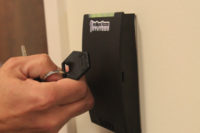Integrator Mike DeVita Jr., senior account executive, Surveillance Specialties, Wilmington, Mass., estimates that smart cards now make up about 10 percent of his business.
“That’s up significantly,†DeVita reports. “As threat levels change, people are more and more apt to want to talk about, ‘What else can I do to add another level of security?’†Increasingly, the answer is smart cards.

Smart Card Technology
Smart cards come in two basic varieties: contact and contactless. Contact is similar in use to a mag stripe technology and must be inserted into a reader. Contactless, with an operation like proximity, is by far the preferred method for any physical security application.“As almost all security integrators are familiar with proximity cards, there is beginning to be a trend towards contactless smart cards, which is not a prox card per se, but works like RFID,†relates Mark Freundlich, president of Indala Corp., San Jose, Calif. “It works at a different frequency and typically has a lot more memory. Smart cards not only read numbers, they can also write to the cards as well.
“Probably the most common cards we’re supplying to the marketplace today are transition cards, which incorporate both proximity and contactless smart card technology, so customers can upgrade readers at their leisure. One card has two technologies to handle whatever applications they want to use it for.â€
This is happening on the reader side as well. “The most exciting thing we are coming out with is a multi-tech reader that will read multiple types of smart cards and proximity cards at the same reader at the same time,†explains Peter Boriskin, chief technology manager for Tyco’s access control and video systems, Lexington, Mass.
“It allows customers who currently have proximity to transition to smart cards,†he points out. “People have not wanted to go to smart card technology because they were afraid of picking the wrong horse. The nice thing about the multi-tech reader is you don’t need to worry about that. The infrastructure will remain the same.â€
Alan Kruglak, senior vice president, Genesis Security Systems, an integrator based in Germantown, Md., believes that multiple technology cards and readers will be around for the foreseeable future.
“The biggest limitation to smart cards is the read range,†he comments. “If you look at the ISO standards 1443a and 1443b, they have about a one-inch read range. That’s not suitable for garage applications. We see a combination of dual technology cards. There is a large base using 125 kHz proximity with flexible read range and incorporating the contactless chip. It’s a proximity smart card.â€
Whether it is dual-technology or straight smart card, the technology is there right now to make it more simple to offer to the end user, declares Randy Vanderhoof, executive director of the Smart Card Alliance, Princeton Junction, N.J. The Smart Card Alliance is a not-for-profit industry association that represents the smart card community in North America.
The product offerings in the smart card market are becoming more off-the-shelf and standardized to make it easier for dealers and integrators to incorporate the technology into their security solutions, according to Vanderhoof. “Implementing smart cards requires having compatibility between the cards, the readers, the security systems databases and the personalization systems.
“It’s very important that the technology is stable, well-documented and able to be combined with other technologies,†he insists. “The technology has made significant advances in that area in the last few years.â€

Early Adopters
Smart card technology has been around for years. However, in terms of actual adoption in the United States, these are still “early days.†That is beginning to change, however.“We are in this transitionary period where people are beginning to see the emergence of alternative smart card technologies for physical access,†observes Ken Francis, vice president of AMAG Technology, Torrance, Calif.
One of the biggest drivers is the U.S. government. “There is a big tendency now to shift into the smart card marketplace,†asserts Kruglak of Genesis Security. “The big change really is being driven by the government. The government is the innovator that corporations tend to follow.â€
Boriskin of Tyco agrees. “With Homeland Security Presidential Directive 12, the government has been tasked with creating a plan and implementing smart card deployment for every government employee or person who works in government space,†Boriskin reports. “With that underway, we’re going to see the coattails of that project pull along a tremendous amount of smart cards in the U.S. We’ve definitely seen more in the past few years, but I think this will be the tipping point.â€
Other markets that are moving toward smart cards for physical security now include health care, educational institutions, financial institutions, large corporations, transportation and utilities.
“What’s common among them is they have large, distributed organizations and have multiple facilities,†Vanderhoof notes. “They are looking for an integrated solution so individuals from one facility can easily visit or transfer to another facility. The larger the organization, the stronger the value of return on investment of having a smart card solution.â€
Integrator DeVita of Surveillance Specialties adds, “It’s still in its infancy. There are very specific types of people and companies that have that comfort level with smart cards. I see it picking up more and more because of health care with HIPAA laws, and biotech because of some FDA laws.
“That added level of security is necessary,†DeVita emphasizes. “We are starting to see more and more people going to smart cards. Mostly what I see is companies that have multiple facilities all over the country or world.â€
However, even with some of these customers going to smart cards, the current market saturation for smart cards is still only around 5 percent, estimates Francis of AMAG Technology. Of the smart card market, probably about 15 percent of the total business belongs to the dealer or integrator, he adds.

Photo courtesy of Indala Corp.
Selling Smart
That leaves a lot of room for improvement and sales. “It is my opinion that we will see that percentage pick up significantly over the next five years,†Francis calculates.Freundlich of Indala agrees. “Last year probably five percent of our card business by volume was transition cards,†he estimates. “This year that will increase to 15 percent and next year to 20 percent.â€
Senior account executive for Surveillance Specialties and president of National Security Integrators (NSI), DeVita also has seen a trend. “There are 13 of us throughout North America,†he says of NSI. “We’re beginning to see a lot more interest in these types of products.â€
Besides specific markets driving smart cards forward, economic factors also are important. “Ten years ago they were very expensive because there were very few on the market,†Francis observes. “That is changing every year for the last 10 years. Today contactless smart card readers are within 10 to 20 percent of standard proximity [pricing]. In fact, with small memory alternatives, they can be the same price or even cheaper.â€
So how can a dealer or integrator take advantage of these trends?
“My advice at this stage in the smart card life cycle is that a fundamental understanding of the return on investment and flexibility of smart cards is a strong differentiator within the dealer population,†Francis advises. “Those companies who are arming themselves with a strong knowledge of the capabilities of smart cards are leveraging the differentiator to successfully secure business.â€
Boriskin adds that a good understanding of the smart card’s functionality is key. “Match the card to the task,†he recommends. “There’s a lot you can do. It’s an open book.
“If you really want to see an increased adaptation of this, have a good understanding of what the card can offer for each of your vertical markets,†he recommends. “Have a good plan in place to work through with your customer. Understand your market and the voice of the customer.â€
Smart cards are here to stay. “The evolution of the technology and the security systems are going to make smart cards become much more of a common technology, just like proximity became the replacement for mag stripe a few years ago,†Vanderhoof comments. “Smart cards will replace proximity. It’s an evolution over time. It will continue to grow.â€
That evolution is the key to moving forward in this market. “I think an important thing [for the dealer] to understand is that the card itself is becoming a user interface for identification and by definition has a lot more value than just physical access,†Freundlich explains. “Going forward, it’s not just a peripheral device, but an interface to many different systems and applications in that community.â€
Sidebar
IT/Security Convergence Can Affect Smart Card Sales
One of the emerging trends in the smart card market involves the channel through which it is entering the marketplace. Although physical security is still a viable market for the smart card, increasingly it can be the logical side that is drawing it into a facility.“We are seeing a great deal of convergence of traditional brick-and-mortar physical security collaborating with IT and CIO departments to bring together a [smart] badge or common credential that is used in both the physical and logical environment,†reports Neville Pattinson, director of business development, technology and government for Axalto (formerly Schlumberger), Austin, Texas.
The reason for this is the strong need for better logical security that can be met uniquely by the smart card. “Most facilities are still using passwords today, which is the worst level of security that exists on probably the most valuable part of the business,†laments Mark Freundlich, president of Indala Corp., San Jose, Calif. “In fact, Microsoft as a company is recommending that smart cards are the most effective way to help secure the IT infrastructure.â€
Increasingly, as IT departments seek logical security options, they are realizing that the physical security department already has a card whether it is smart or not. Consequently, they are recommending a smart or combination card as a single credential.
“Having a one-card solution for physical and logical access in many business cases pays for itself,†Freundlich asserts. “There is a strong business case to support this move.â€
In the best-case scenario, this is good news for the security dealer, but there are caveats. Currently, smart cards generally are sold through one of two channels: the one-card solution provider or the physical security integrator, explains Peter Boriskin, chief technology manager for Tyco’s access control and video systems, Lexington, Mass.
Increasingly, however, the logical security integrator or network security provider is part of the mix. “In some cases, they are riding on the coattails of physical security, and in some cases they are bringing in physical security afterwards,†he adds.
This can lead to a negative situation for the user. “Often who brings it to management is the channel and market that it goes through,†Freundlich maintains. “If it’s being brought forth by the security manager, it usually goes through our security dealer/integrator channel.
“But if it comes through IT, it can go through a [logical] security integrator who may not know anything about physical security,†Freundlich explains. “Then you end up with employees running around with two or three cards.â€
Suggests Randy Vanderhoof, executive director of the Smart Card Alliance, Princeton Junction, N.J. “IT shouldn’t be in a position to issue their own access cards but rather piggyback their needs onto the existing platform under physical security.â€
In this way, “there is a convergence of need where IT departments are looking to introduce stronger authentication for their computer networks and physical security is looking for more capable ID credentials,†Vanaderhoof points out. “This provides a more integrated systems approach to overall security.â€
It also has the added benefit of boosting the physical security case for smart cards. “It’s difficult justifying just a physical badge these days,†adds Pattinson of Axalto. “By combining physical with logical access, you give a very good business case for supplying very capable smart cards into the agency.â€





